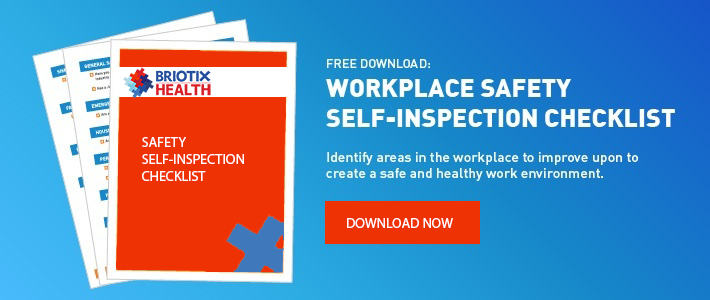
Are you experiencing discomfort, pain, or fatigue during your workday? Are you spending extended periods of time performing repetitive work in awkward postures, lifting heavy loads without adequate support? If so, you may be at an increased risk of developing ergonomic work-related musculoskeletal disorders (MSDs), such as lower back injuries, carpal tunnel syndrome, contact stress, torn ligaments, etc. Thankfully, there are measures that you can implement to recognize and alleviate ergonomic challenges in the workplace.
In this blog, we will take a deep dive into the five most important steps to identifying ergonomic risk factors in the workplace, including a workplace analysis, evaluating work tasks, postures, and movements, reviewing worker feedback, developing and implementing control measures, and monitoring the effectiveness of the occupational health and ergonomics program. These measures can help cultivate a work environment that prioritizes occupational safety for you and your coworkers.
What are the five most important steps to identifying ergonomic risk factors in the workplace?
- Conducting a workplace analysis
- Evaluating work postures, movements, and forces
- Reviewing workers' feedback and complaints
- Developing and implementing control measures
- Monitoring the effectiveness of the control measures
Let's take a deeper look at each of these steps.

1. Conduct a Workplace Analysis
This step involves reviewing the work environment, identifying repetitive tasks, and work activity that may pose ergonomic risks. It is essential to look at the physical and organizational characteristics of the work environment, such as the layout of the workspace, lighting, temperature, noise, and pace of work.
Review the work environment and identify tasks and activities that pose ergonomic risks.
- Ergonomic assessments: Ergo Evaluations involve analyzing the job's physical demands and identifying potential ergonomic concerns. It can be done with observation, interviews with workers, and specialized equipment to measure physical stress on the body.
- Review incident and injury reports: By delving into incident and injury reports, you can discover trends and patterns that may reveal areas of concern. This can allow you to zero in on specific tasks and activities that pose potential ergonomic risks and address them before they become major problems. With a little detective work, you can help create a safer, healthier, and more ergonomic workplace for everyone.
- Survey workers: Unlock valuable information about potential ergonomic risks by surveying workers and exploring their experiences and concerns. By asking the right questions, you can uncover critical details about tasks and activities that may be causing discomfort or pain, giving you the information you need to address potential hazards and create a safer and more ergonomic workplace. With a little effort and the willingness to listen, you can work with your team to identify and address ergonomic risks, promoting a happier, healthier, and more productive workplace for all.
- Reviewing production records: By peering into production records, you can detect tasks and activities that may be subjecting workers to repetitive motions, overexertion, or other ergonomic threats. Armed with this knowledge, you can take proactive steps to address potential hazards, minimize the risk of injury and discomfort, and optimize your production processes for maximum efficiency and safety.
- Observing work practices: By observing how tasks are performed, you can identify tasks and activities that may be causing ergonomic hazards. This can aid you in pinpointing potential areas for improvement and creating effective control measures.
Look at the physical and organizational characteristics of the work environment, such as the layout of the workspace, lighting, temperature, noise, and pace of work.
- Walk through the workspace: By physically walking through the workspace, you can get a firsthand sense of the layout, lighting, temperature, noise levels, and pace of work. This can enable you to spot potential hazards lurking beneath the surface, such as poor lighting that can lead to eye strain, tripping hazards that can cause falls and injuries, or excessive noise levels that can damage workers' hearing and increase stress. Armed with this information, you can take proactive steps to address these hazards and create a safer, healthier, and more ergonomic work environment for everyone. So why not take a stroll and see what you can discover?
- Complete a safety inspection: You can survey workers to get their opinions on the physical and organizational characteristics of the work environment. This can help you identify areas of concern and gather ideas for improvement.

- Reviewing safety data: You can check safety data to identify patterns and trends that may suggest areas of concern. For example, suppose there are many slips, trips, and falls in a particular area. In that case, this may indicate hazardous workplace conditions that need to be addressed.
Consider the demographics of the workforce, including age, physical ability, and gender.
- Organize a demographic survey: You can survey the workforce to gather information on demographics, such as age, physical ability, and gender. This can help you identify potential risks and develop solutions tailored to your workforce's needs.
- Analyzing incident and injury data: You can analyze incident and injury data to identify patterns and trends that may suggest areas of concern. For example, if there are many ergonomic injuries among older workers, this may suggest a need for ergonomic solutions tailored to the needs of an aging workforce.
- Observing workers: By observing workers, you can get a better sense of the physical abilities and limitations of the workforce.

2. Evaluate Postures, Movements, and Forces
Once the work environment has been assessed, it is necessary to consider a job's physical demands on workers' bodies. This includes evaluating the postures, movements, and forces required to perform their tasks to identify ergonomic risk factors. This step may involve observing workers performing their duties, performing interviews, or using specialized equipment to measure physical stress on the musculoskeletal system.
Evaluate the physical demands of the job on workers' bodies.
- Complete a job analysis: A job analysis involves breaking down each task associated with a job and identifying the physical demands associated with each one. This can be achieved through observation, interviews with workers, and specialized equipment to measure physical stress on the body.
- Consulting with experts: You can consult ergonomic experts to understand the job's physical demands better. They can provide recommendations for improvements based on their experience and expertise.

Evaluate the postures, movements, and forces required to perform tasks to identify potential ergonomic risk factors.
- Using ergonomic assessment tools: There are a variety of ergonomic assessment tools available that can be used to evaluate the postures, movements, and forces required to perform tasks. These tools typically involve rating the physical demand associated with each task and identifying areas of concern.
- Observing workers: By observing workers performing their tasks, you can get a better grip on the postures, movements, and forces required to complete the job. This can help you identify potential ergonomic pitfalls and develop solutions to decrease prevalence or eliminate those hazards.
Observe workers performing tasks, conduct interviews, or use specialized equipment to measure physical stress on the body.
- Time and motion study: This involves observing workers performing job tasks over long periods of time to determine the time required to complete each step and the job's physical demands.
- Using thermal imaging cameras: Thermal imaging cameras can measure changes in skin temperature, indicating areas of the body under physical stress.
- Risk assessment: This involves identifying potential hazards associated with specific tasks and determining the risk associated with each threat.
- Using 3D motion capture technology: 3D motion capture technology involves using cameras and sensors to create a virtual representation of workers performing their tasks. This can provide a detailed understanding of the postures and movements required to perform tasks and help identify potential ergonomic hazards.
- Participatory ergonomics program: Ergonomic programs entail collaborating with workers to pinpoint potential ergonomic hazards and tailor solutions to their unique needs. This may include interviews, observing workers performing tasks, or using specialized equipment to measure physical stress on the body.
Sign up now and get the FULL downloadable guide to identifying these ergonomic risks in your workplace for FREE! Enter your email and get instant access to this powerhouse resource now!
Briotix Health Can Help
As an employer or employee, it is essential to take action to address ergonomic hazards in the workplace. By adhering to the guidelines presented in this article and instituting a proficient ergonomic program, you can assist in diminishing the chances of injury and discomfort among workers, fostering a more productive and efficient work environment, and maintaining conformity with applicable regulations and standards. So, take the first step today by reviewing the work environment and identifying potential ergonomic hazards. Engage workers in the process, and work together to implement control measures that will help protect their health, safety, and well-being. Remember, creating a safe and comfortable work environment is essential for a happy, healthy, and productive workforce, so act today to make your workplace ergonomically safe!


